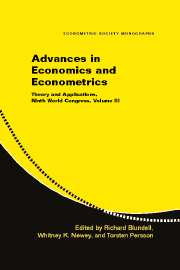Book contents
- Frontmatter
- Contents
- Contributors
- Introduction by the Editors
- 1 Identification of Nonadditive Structural Functions
- 2 Nonadditive Models with Endogenous Regressors
- 3 Heterogeneity and Microeconometrics Modeling
- 4 Heterogeneous Choice
- 5 Modeling Heterogeneity
- 6 Inference with Weak Instruments
- 7 Empirical Likelihood Methods in Econometrics: Theory and Practice
- 8 Weak Instruments and Empirical Likelihood: A Discussion of the Papers by D. W. K. Andrews, J. H. Stock, and Y. Kitamura
- 9 Estimating Continuous-Time Models with Discretely Sampled Data
- 10 Variation, Jumps, and High-Frequency Data in Financial Econometrics
- 11 Discussion of Aït-Sahalia and Barndorff-Nielsen and Shephard
- 12 Understanding Bias in Nonlinear Panel Models: Some Recent Developments
- 13 Fixed and Random Effects in Nonlinear Panel Data Model: A Discussion of a Paper by Manuel Arellano and Jinyong Hahn
- Index
- Titles in the series
12 - Understanding Bias in Nonlinear Panel Models: Some Recent Developments
Published online by Cambridge University Press: 05 January 2013
- Frontmatter
- Contents
- Contributors
- Introduction by the Editors
- 1 Identification of Nonadditive Structural Functions
- 2 Nonadditive Models with Endogenous Regressors
- 3 Heterogeneity and Microeconometrics Modeling
- 4 Heterogeneous Choice
- 5 Modeling Heterogeneity
- 6 Inference with Weak Instruments
- 7 Empirical Likelihood Methods in Econometrics: Theory and Practice
- 8 Weak Instruments and Empirical Likelihood: A Discussion of the Papers by D. W. K. Andrews, J. H. Stock, and Y. Kitamura
- 9 Estimating Continuous-Time Models with Discretely Sampled Data
- 10 Variation, Jumps, and High-Frequency Data in Financial Econometrics
- 11 Discussion of Aït-Sahalia and Barndorff-Nielsen and Shephard
- 12 Understanding Bias in Nonlinear Panel Models: Some Recent Developments
- 13 Fixed and Random Effects in Nonlinear Panel Data Model: A Discussion of a Paper by Manuel Arellano and Jinyong Hahn
- Index
- Titles in the series
Summary
INTRODUCTION
The purpose of this paper is to review recently developed bias-adjusted methods of estimation of nonlinear panel data models with fixed effects. Standard estimators such as maximum likelihood estimators are usually inconsistent if the number of individuals n goes to infinity while the number of time periods T is held fixed. For some models, like static linear and logit regressions, there exist fixed-T consistent estimators as n→∞ (see, e.g., Andersen, 1970). Fixed T consistency is a desirable property because for many panels T is much smaller than n. However, these type of estimators are not available in general, and when they are, their properties do not normally extend to estimates of average marginal effects, which are often parameters of interest. Moreover, without auxiliary assumptions, the common parameters of certain nonlinear fixed effects models are simply unidentified in a fixed T setting, so that fixed-T consistent point estimation is not possible (see, e.g., Chamberlain, 1992). In other cases, although identifiable, fixed-T consistent estimation at the standard root-n rate is impossible (see, e.g., Honoré and Kyriazidou, 2000; Hahn, 2001).
The number of periods available for many household, firm-level or country panels is such that it is not less natural to talk of time-series finite sample bias than of fixed-T inconsistency or underidentification. In this light, an alternative reaction to the fact that micro panels are short is to ask for approximately unbiased estimators as opposed to estimators with no bias at all.
Information
- Type
- Chapter
- Information
- Advances in Economics and EconometricsTheory and Applications, Ninth World Congress, pp. 381 - 409Publisher: Cambridge University PressPrint publication year: 2007
Accessibility standard: Unknown
Why this information is here
This section outlines the accessibility features of this content - including support for screen readers, full keyboard navigation and high-contrast display options. This may not be relevant for you.Accessibility Information
- 25
- Cited by
